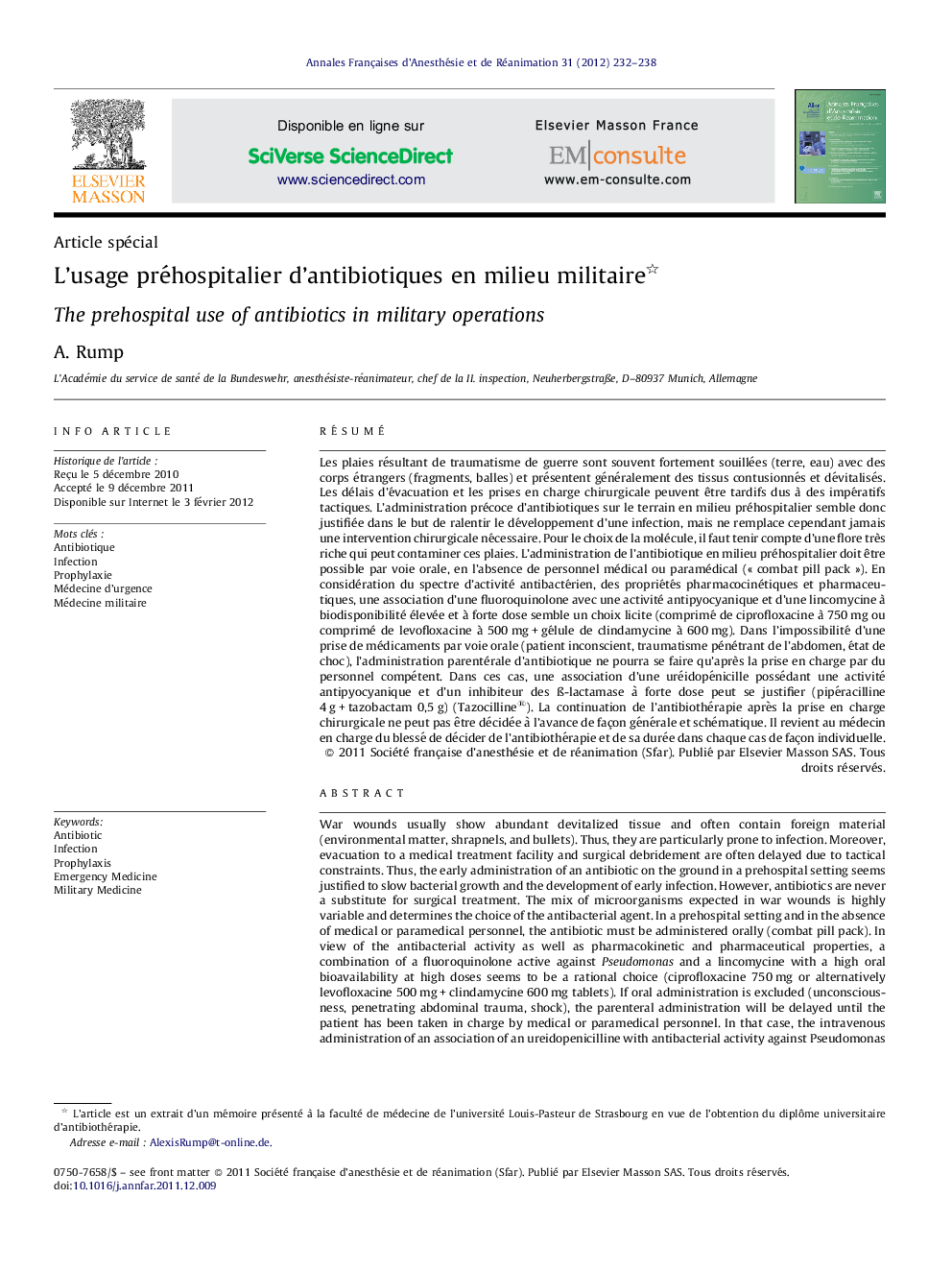| کد مقاله | کد نشریه | سال انتشار | مقاله انگلیسی | نسخه تمام متن |
|---|---|---|---|---|
| 2746034 | 1148859 | 2012 | 7 صفحه PDF | دانلود رایگان |

RésuméLes plaies résultant de traumatisme de guerre sont souvent fortement souillées (terre, eau) avec des corps étrangers (fragments, balles) et présentent généralement des tissus contusionnés et dévitalisés. Les délais d’évacuation et les prises en charge chirurgicale peuvent être tardifs dus à des impératifs tactiques. L’administration précoce d’antibiotiques sur le terrain en milieu préhospitalier semble donc justifiée dans le but de ralentir le développement d’une infection, mais ne remplace cependant jamais une intervention chirurgicale nécessaire. Pour le choix de la molécule, il faut tenir compte d’une flore très riche qui peut contaminer ces plaies. L’administration de l’antibiotique en milieu préhospitalier doit être possible par voie orale, en l’absence de personnel médical ou paramédical (« combat pill pack »). En considération du spectre d’activité antibactérien, des propriétés pharmacocinétiques et pharmaceutiques, une association d’une fluoroquinolone avec une activité antipyocyanique et d’une lincomycine à biodisponibilité élevée et à forte dose semble un choix licite (comprimé de ciprofloxacine à 750 mg ou comprimé de levofloxacine à 500 mg + gélule de clindamycine à 600 mg). Dans l’impossibilité d’une prise de médicaments par voie orale (patient inconscient, traumatisme pénétrant de l’abdomen, état de choc), l’administration parentérale d’antibiotique ne pourra se faire qu’après la prise en charge par du personnel compétent. Dans ces cas, une association d’une uréidopénicille possédant une activité antipyocyanique et d’un inhibiteur des ß-lactamase à forte dose peut se justifier (pipéracilline 4 g + tazobactam 0,5 g) (Tazocilline®). La continuation de l’antibiothérapie après la prise en charge chirurgicale ne peut pas être décidée à l’avance de façon générale et schématique. Il revient au médecin en charge du blessé de décider de l’antibiothérapie et de sa durée dans chaque cas de façon individuelle.
War wounds usually show abundant devitalized tissue and often contain foreign material (environmental matter, shrapnels, and bullets). Thus, they are particularly prone to infection. Moreover, evacuation to a medical treatment facility and surgical debridement are often delayed due to tactical constraints. Thus, the early administration of an antibiotic on the ground in a prehospital setting seems justified to slow bacterial growth and the development of early infection. However, antibiotics are never a substitute for surgical treatment. The mix of microorganisms expected in war wounds is highly variable and determines the choice of the antibacterial agent. In a prehospital setting and in the absence of medical or paramedical personnel, the antibiotic must be administered orally (combat pill pack). In view of the antibacterial activity as well as pharmacokinetic and pharmaceutical properties, a combination of a fluoroquinolone active against Pseudomonas and a lincomycine with a high oral bioavailability at high doses seems to be a rational choice (ciprofloxacine 750 mg or alternatively levofloxacine 500 mg + clindamycine 600 mg tablets). If oral administration is excluded (unconsciousness, penetrating abdominal trauma, shock), the parenteral administration will be delayed until the patient has been taken in charge by medical or paramedical personnel. In that case, the intravenous administration of an association of an ureidopenicilline with antibacterial activity against Pseudomonas and a ß-lactamase-inhibitor at high doses could be a rational choice (piperacilline 4 g + tazobactam 0,5 g) (Tazocilline®). An antibiotic treatment beyond the time of surgery may become necessary in individual patients depending on the local features of the wound and should be prescribed by the medical officer in charge of the patient on a case-by-case basis.
Journal: Annales Françaises d'Anesthésie et de Réanimation - Volume 31, Issue 3, March 2012, Pages 232–238